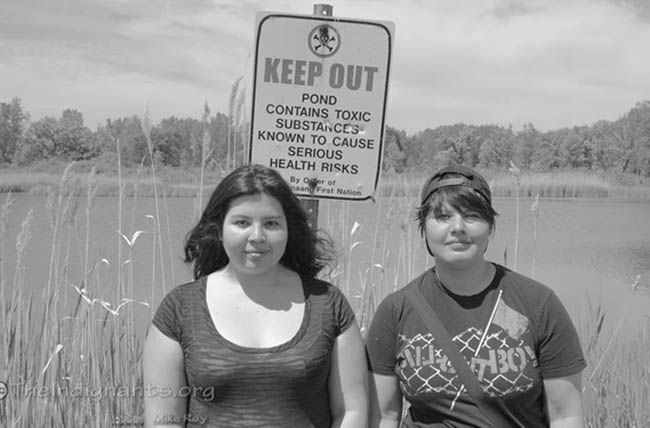Sisters host ‘Toxic Tours’ of their home in Canada’s Chemical Valley

By Rick Garrick
Two Aamjiwnaang sisters — former Green Teens — are hosting toxic tours of Canada’s Chemical Valley, which includes 63 petrochemical plants located adjacent to their home community.
“We host these walks through Chemical Valley (for people) to experience the front line,” says Vanessa Gray, a 22-year-old grassroots organizer and Trent University indigenous environmental studies student. “Let’s show you what our reality is like, let’s lie our tobacco down for the water and for the land together and let’s pray in ceremony and let’s set up a sacred fire and let’s talk about solutions.”
A number of studies have found that about 40 per cent of Aamjiwnaang’s residents use inhalers, 17 per cent of adults and 22 per cent of children have asthma and about 35 per cent of births between 1999-2003 were male compared to about 65 per cent female in the Upper Canada Treaties Area 2 community.
“Living in Chemical Valley, you don’t realize the effects that it causes,” says Lindsay Gray, Vanessa’s 19-year-old sister who studies general arts at Seneca College. “We lose so many loved ones, family members and community members … from illness and we also have a lot of sad statistics, like two girls for every boy in our community.”
Vanessa says many Chemical Valley companies, such as Suncor Energy, Shell Canada and Imperial Oil, are within walking distance from Aamjiwnaang’s homes.
“For us (community members), it is very normal to be that close to these multi-national oil companies,” Vanessa says. “But for many people this is not their reality and it’s a big shock to see how obviously violent this is to our health and land.”
Lindsay says the toxic tour participants often find it hard to breathe at some points during the tour, noting the community is exposed to a wide range of smells such as plastic, burning rubber and sulphur and she has been evacuated from her home on more than one occasion due to dangerous spills.
“Some people call it the Sarnia nose, where we’re so immune to those smells,” Lindsay says. “We were told once that our noses have been a little bit desensitized because we are constantly smelling different things.”
The toxic tours are organized as part of the Aamjiwnaang and Sarnia Against Pipelines protests against Enbridge Inc.’s 639-kilometre reversed Line 9 pipeline between Sarnia and Montreal.
“We bring people from all around … on a tour of Chemical Valley,” Lindsay says. “One thing I really like to show people is how much pollution affects us — there’s noise pollution, there’s the breathing in of pollution.”
Vanessa began raising awareness about Chemical Valley’s effects on her community after being inspired by a group of women working against the tar sands in northern Alberta.
“I felt the effects from the Chemical Valley (as I was) growing up,” Vanessa says. “Myself, my brother and my sister all suffered from asthma and we were always aware that the water was unsafe. So that was very normal for us to be living in such a contaminated space and not knowing how wrong this was.”
Vanessa plans to conduct a study in the future to investigate how toxic her community’s land and water is and if there is anything that can be done about the contamination.
“Yes, our water is toxic, we are aware that it is dangerous for our health,” Vanessa says. “But we have so many unanswered questions: what is in this water, who is responsible for dumping in our water source.”


